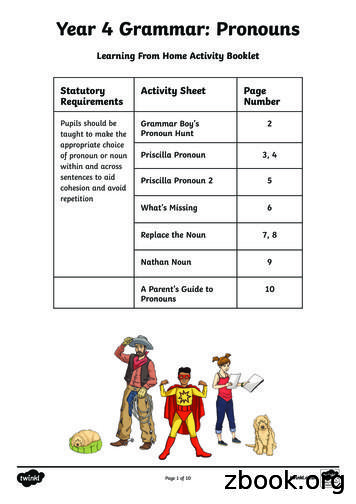Double Pronouns - Norwell High School
Double PronounsDOPs con IOPs
REVIEW: What is a Direct Object?A direct object is a THING or a PERSON thatreceives the ac6on of the verb.EX:I eat the tamales.Yo como los tamales.EX:Óscar calls his wife.Óscar llama a su esposa.
What is a Direct Object?Direct objects typically FOLLOW the verb (inboth Spanish and English.EX:I eat the tamales.Yo como los tamales.EX:Óscar calls his wife.Óscar llama a su esposa.
What is a Direct Object?We can find the direct object of asentence is by asking WHAT or WHOis geBng VERBED?I eat the tamales.Yo como los tamales.the tamalesThe tamales are the D.O.What do I eat?
What is a Direct Object?We can find the direct object of a sentenceis by asking WHAT or WHO is geBngVERBED?Óscar calls his wife.Óscar llama a su esposa.Who does Óscar call?His wife.His wife is the D.O.
Direct Object PRONOUNSDirect Object pronouns are used toREPLACE the D.O. of a sentence toavoid repe66on.We will never have the DO noun andthe DO pronoun in the samesentence
Spanish DOPsSINGULARPLURALmenosteoslo, lalos, las
SINGULARPLURALmenostelo, laosUsedexclusivelyforreplacingD.O.s thatrefer toPEOPLE.los, lasUsed for D.O.s thatrefer to PEOPLE andTHINGS.
Follow 3 easy steps to substitute aDIRECT OBJECT PRONOUN for adirect object:(1)Identify the direct object by finding theverb in the sentence and asking who? Orwhat? Is receiving the action of the verb.Maria compra la camiseta.verb¿Qué compra Maria?
Follow 3 easy steps to substitute aDIRECT OBJECT PRONOUN for adirect object:(2)Identify the NUMBER and GENDER (ifnecessary) of the direct object Maria compra la camiseta.feminine/singular and substitute the appropriate DIRECTOBJECT PRONOUN.Maria compra la camiseta.LA
Follow 3 easy steps to substitute aDIRECT OBJECT PRONOUN for adirect object:(3) Place the DIRECT OBJECT PRONOUNMaria la compra. more details to comeon that!
Pronoun PlacementAll pronouns (D.O.’s and I.O.’s) can go in thefollowing places:1.) Before a conjugated verbEX: Yo te veo en el espejo. (I see you in themirror)
Pronoun PlacementAll pronouns (D.O.’s and I.O.’s) can go in thefollowing places:2.) ATTACHED to an infini6veEX: Yo quiero comprarlo.
“Un verbo, un lugar.Dos verbos, dos lugares”
Completen la prácPca delos DOPs en tu hoja.
Respuestas:1.) Tú buscaste a nosotros.2.) Uds. pidieron la ensalada.3.) Yo tengo que decir laspalabras.4.) Ellos desearon invitar a mí.5.) Nosotros servimos losentremeses.
REVIEW: What is an Indirect Object?An indirect object is a THING or a PERSON thatreceives the direct object of the verb or expressesfor whom the ac6on is done.EX:I buy my mom the tamales.Yo le compro las tamales a mi madre.Óscar tells his wife the story .EX:Óscar le dice el cuento a su esposa.
REVIEW: What is an Indirect Object?We can find the indirect object of asentence is by asking TO/FOR WHOM orTO/FOR WHAT?Óscar tells his wife the truth.Óscar le dice la verdad a su esposa.To whom does Óscar tell the truth?His wife.His wife is the I.O.
ClarityUNLIKE DOPS, the IOPs can REPLACE orACCOMPANY indirect objects .ACCOMPANY:Rosa le compra el boleto a su madre.Rosa buys the ,cket for her mother.REPLACE:Rosa le compra el boleto.Rosa buys the ,cket for her.
HOWEVER:You cannot have a sentence withan indirect object that does notalso have an IOP.Any sentence with an IO (impliedor stated) must have an IOP.
Spanish IOPsSINGULARPLURALmenosteosleles
Completen la prácPca delos DOPs en tu hoja.
Write the corresponding I.O.P.1.) Tomásme pasa el libro a mí.le compras un regalo a tu amigo.2.) Túles decimos la verdad a ellos.3.) Nosotrosos cuento la historia a vosotros.4.) Yonos5.) Los estudiantes pasannotas a nosotros.6.) Ella siemprete dice la verdad a 7.
In Spanish, DIRECT and INDIRECT ObjectPronouns are often found together in thesame sentence.Direct Object Pronouns Indirect Object Pronounsmenosmenos(ex.)teosteoslolaloslasleles¿Te explica la gramática la Sra. Callahan (a ti)?Sí, la Sra. Callahan me la explica.
DOP IOPSome6mes, we are going to wantto subs6tute out BOTH the DOand the IO.When we do this, we must followsome rules
La posiciónCuando hay un IOP y DOP, siempre se6enen que quedar JUNTOS y el IOPestá enfrente del DOP.EX: Yo te voy a comprar un anillo deplata.EX: Te lo voy a comprar.IOPDOP
La posiciónCuando hay un IOP y DOP, siempre se6enen que quedar JUNTOS y el IOPestá enfrente del DOP.EX: Yo te voy a comprar un anillo deplata.EX: Voy a comprartelo.IOPDOP
The LE/LO ruleWhen you have both a DOP and IOP in asentence, you may NOT have;LE/LES followed by LO/LA/LOS/LAS.This is called the LELO rule, and it isUNACCEPTABLE!!!EX: Héctor le da el anillo a Estefanía.If we replace the DO with a DOP, we would have:Héctor le lo da a Estefanía.
The LE/LO ruleWhen this happens, the third person IOP (Le/les)will change to SE to prevent the LELO rule fromhappening:EX: Héctor le da el anillo a Estefanía.If we replace the DO with a DOP, we would have:Héctor se lo da a Estefanía.
La Posición de los PronombresRecuerden:“ Un verbo, un lugar. Dos verbos, dos lugares.”Pronombres pueden estar:1. Antes de un verbo conjugado2. Atachado a un infini6vo
In a sentence that uses an INFINITIVE or aPRESENT PARTICIPLE, you can put the DOUBLEOBJECT PRONOUNS before the conjugatedverb.Mis padres me las van a comprar.or attach it to the infinitive.Mis padres van a comprármelas.
Completen la prácPca delo DOPs/IOPs en tu hoja.
Replace and rewrite:Yolanda me quiere dar su sándwich.Yolanda me lo quiere dar.OYolanda quiere dármelo.
Replace and rewrite:Tomás escribió unos mensajes a los otrosestudiantes.Tomás se los escribió.
Replace and rewrite:Te compramos unos aretes bonitos.Te los compramos.
Replace and rewrite:Tú le regalas una blusa negra a tumadre.Tú se la regalas (a tu madre.)
Replace and rewrite:Uds. me van a comprar unosentremeses.Uds. me los van a comprar.OUds. van a comprármelos.
Rewrite the sentences below substituting a DIRECTOBJECT PRONOUN for the DIRECT OBJECT. Makechanges as necessary.1.Mi amigo me manda los papeles.Mi amigo me los manda.2.Yo le presto un lápiz.Yo se lo presto.3.Mis padres les dan una fiesta grande.Mis padres se la dan.4.¿Te escribe Adela una carta?¿Te la escribe Adela?
Answer the following questions about your TEACHERS:1.¿Quién les da examenes fáciles a los alumnos?se los da.2.¿Quién les da mucha tarea a los alumnos?se la da.3.¿Quién les presta unos lápices a los alumnos?se los presta.4.¿Quién les explica las lecciones a los alumnos?se las explica.
UNLIKE DOPS, the IOPs can REPLACE or ACCOMPANY indirect objects . ACCOMPANY: Rosa le compra el boleto a su madre. Rosa buys the ,cket for her mother. REPLACE: Rosa le compra el boleto. Rosa buys the ,cket for her.
page 20 To choose pronouns appropriately. Pronouns in text page 24 To investigate the use of pronouns. Pronouns in writing page 28 To extend the use of pronouns in writing. oduction oster notes Pronouns (page 10) This poster presents the various words that can function as personal pronouns
Personal Pronouns I, you, he, she Possessive Pronouns my, his, her, mine, ours, theirs Reflexive Pronouns myself, herself, himself Reciprocal Pronouns each other, one another Indefinite Pronouns anything, somebody, everyone, few, both, neither Relative Pronouns who, which, what, that, when, where Inter
Lesson 22 t Intensive and Reflexive Pronouns Reflexive Pronouns Reflexive pronouns are a bit different from the other kinds of pronouns. They cause the verb to reflect back on the subject . In other words, reflexive pronouns are used when the subject of the sentenc
Double Object Pronouns Double object pronouns occur when both the indirect and direct object pronouns are used together with the same verb. Both the indirect and direct object precede the verb. The indirect object comes before the direct object. Miguel me dio el
page 2. Grammar Boy’s Pronoun Hunt. 1. I 2. he 3. his 4. ours 5. mine 6. yours 7. she 8. it 9. they Year 4 Grammar: Pronouns Answers page 3, 4. Priscilla Pronoun. Personal Pronouns Possessive Pronoun Relative Pronouns Reflexive Pronouns Demonstrative Pronouns I you he she it we they me him
Part 1: Personal Pronouns Singular Personal Pronouns I me my, mine you you your, yours he, she, it him, her, it his, hers, its Let’s Run a Drill! Directions: Underlinethe personal pronouns in the following sentences. (The number of personal pronouns in each sentence is given in parentheses.) Plural Personal Pronouns we
repetition of using his name again. Please see below for a list of personal pronouns: Possessive Pronouns Possessive pronouns show ownership or who something belongs to. They are: mine, yours, his, hers, its, ours, yours, theirs. Relative Pronouns Relative pronouns are: who, whose,
Pronouns Relative pronouns have different functions They introduce a clause (the part of a sentence that gives more information about the noun). They connect the clause to the rest of the sentence. Relative pronouns can be found in sentences with more than one clause. o I cannot believe that she said it. o He who begins late finishes last























